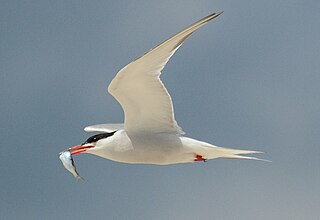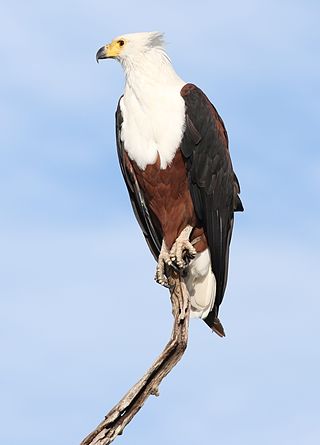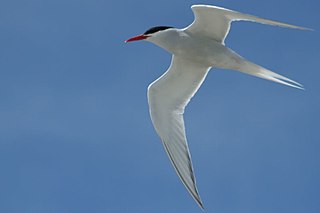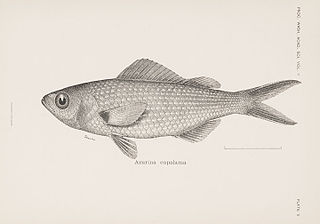
Mackerel is a common name applied to a number of different species of pelagic fish, mostly from the family Scombridae. They are found in both temperate and tropical seas, mostly living along the coast or offshore in the oceanic environment.

Sardine and pilchard are common names for various species of small, oily forage fish in the herring family Clupeidae. The term sardine was first used in English during the early 15th century; a somewhat dubious folk etymology says it comes from the Italian island of Sardinia, around which sardines were once supposedly abundant.

The common tern is a seabird in the family Laridae. This bird has a circumpolar distribution, its four subspecies breeding in temperate and subarctic regions of Europe, Asia and North America. It is strongly migratory, wintering in coastal tropical and subtropical regions. Breeding adults have light grey upperparts, white to very light grey underparts, a black cap, orange-red legs, and a narrow pointed bill. Depending on the subspecies, the bill may be mostly red with a black tip or all black. There are several similar species, including the partly sympatric Arctic tern, which can be separated on plumage details, leg and bill colour, or vocalisations.

The red-rumped swallow is a small passerine bird in the swallow family. It breeds in open hilly country of temperate southern Europe and Asia from Portugal and Spain to Japan, India, Sri Lanka and tropical Africa. The Indian and African birds are resident, but European and other Asian birds are migratory. They winter in Africa or India and are vagrants to Christmas Island and northern Australia.

The Pacific swallow is a small passerine bird in the swallow family. It breeds in tropical southern Asia and the islands of the south Pacific. It is resident apart from some local seasonal movements. This bird is associated with coasts, but is increasingly spreading to forested uplands. The hill swallow and the welcome swallow were formerly considered conspecific.

The wire-tailed swallow is a small passerine bird in the swallow family. It has two subspecies: H. s. smithii, which occurs throughout Africa, and H. s. filifera, which is found in southern and southeastern Asia. It is mainly resident, but populations in Pakistan and northern India migrate further south in winter. The genus name Hirundo is the Latin word for swallow. The species name smithii commemorates Christen Smith, a Norwegian botanist and geologist.

The welcome swallow is a small passerine bird in the swallow family.

The Acrochordidae, commonly known as wart snakes, Java wart snakes, file snakes, elephant trunk snakes, or dogface snakes are a monogeneric family created for the genus Acrochordus. This is a group of basal aquatic snakes found in Australia and tropical Asia. Currently, three species are recognized.

The African fish eagle or the African sea eagle, is a large species of eagle found throughout sub-Saharan Africa wherever large bodies of open water with an abundant food supply occur. It is the national bird of Malawi, Namibia, Zambia, and Zimbabwe. As a result of its large range, it is known in many languages. Examples of names include: Vis Arend in Afrikaans, nkwazi in Chewa, aigle pêcheur in French, hungwe in Shona, inkwazi in isiZulu, and ntšhu in Northern Sotho. This species may resemble the bald eagle in appearance; though related, the two species occurs on different continents, with the bald eagle being resident in North America.

The tree martin is a member of the swallow family of passerine birds. It breeds in Australia, mostly south of latitude 20°S and on Timor island. It is migratory, wintering through most of Australia, New Guinea, Indonesia east of the Wallace Line and the Solomon Islands. It is a vagrant to New Zealand, where it has bred, and New Caledonia. This species is frequently placed in the genus Hirundo as Hirundo nigricans.

The dark-winged lesser house bat is a species of vesper bat. It can be found in Angola, Benin, Cameroon, Central African Republic, Chad, Democratic Republic of the Congo, Republic of Côte d'Ivoire, Ethiopia, Gambia, Ghana, Guinea, Kenya, Malawi, Mozambique, Nigeria, Senegal, Sierra Leone, Somalia, Sudan, Tanzania, Uganda, and Zambia.

The South American tern is a species of tern found in coastal regions of southern South America, including the Falkland Islands, ranging north to Peru and Brazil. It is generally the most common tern in its range. The smaller, highly migratory common tern closely resembles it. The specific epithet refers to the "swallow-like" forked tail feathering.

The Ethiopian swallow is a species of bird in the family Hirundinidae. Although it is non-migratory, its range is wide, extending from Benin to Burkina Faso, Cameroon, Central African Republic, Chad, Democratic Republic of the Congo, Ivory Coast, Eritrea, Ethiopia, Ghana, Guinea, Israel, Kenya, Mali, Niger, Nigeria, Senegal, Somalia, Sudan, Tanzania, Togo, Uganda.

The Angola swallow is a species of swallow that is native to the Afrotropics.

The South African cliff swallow, also known as the South African swallow, is a species of bird in the family Hirundinidae native to central−western and southern Africa.
Taiamã Ecological Station is an ecological station in the Mato Grosso state of Brazil.

The tub gurnard, also known as the sapphirine gurnard, tube-fish, tubfish or yellow gurnard, is a species of marine ray-finned fish belonging to the family Triglidae, the gurnards and sea robins. It is found in the eastern Atlantic Ocean. It is exploited by commercial fisheries as a food fish.

The Galápagos damsel, also known as the blackspot chromis, is a possibly extinct fish species from the family Pomacentridae. It is endemic to the waters near the Galápagos Islands and Cocos Island.
Cap Island Conservation Park is a protected area in the Australian state of South Australia located about 7.5 kilometres (4.7 mi) offshore, west of Mount Misery, Eyre Peninsula. The park covers Cap Island's 8ha surface. The island consists of a granite base and a calcarenite mantle; its margins steeply over-hanging and eroded. Typical vegetation is a low Nitre Bush shrubland. Cap Island Conservation Park was constituted by statute in 1972 to conserve a sea bird breeding area and Australian Sea-lion and New Zealand Fur-seal haul-out areas.

Azurina atrilobata, commonly known as the scissortail damselfish, is a species of damselfish in the family Pomacentridae. It can be found in the eastern Pacific Ocean from the Gulf of California to northern Peru, including the Galapagos Islands and the Cocos Islands. It inhabits coral and rocky reefs. It aggregates in large numbers in open water above reefs. It feeds on zooplankton. It is not strongly territorial. In the darkness of deep water, it becomes invisible save for its post-dorsal white spot, giving the illusion of glowing in the dark. It is oviparous, and the males of the species guard and aerate the eggs.



















